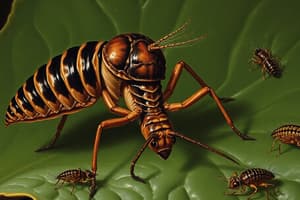Podcast
Questions and Answers
What is the characteristic of amphibians?
What is the characteristic of amphibians?
- They are covered by scutes
- They are terrestrial, aquatic, or aerial
- They are covered with feathers and have streamlined avenues
- They live in the land and move to water for breeding (correct)
The open type of circulatory system is found in Chordates and Arthropods.
The open type of circulatory system is found in Chordates and Arthropods.
False (B)
What is the organ level of organization in animals?
What is the organ level of organization in animals?
The organ level of organization in animals is where animal tissues comprising of similar capacity are classified into shaped organs, each with a definite function.
The _______________________ level of organization consists of animals with cells that are formed as free cell lumps.
The _______________________ level of organization consists of animals with cells that are formed as free cell lumps.
Match the following body symmetry types with their descriptions:
Match the following body symmetry types with their descriptions:
What is a characteristic that distinguishes animals from algae and plants?
What is a characteristic that distinguishes animals from algae and plants?
All animals are unicellular.
All animals are unicellular.
What is the process by which protozoa take in food?
What is the process by which protozoa take in food?
Bryozoans are also known as _______________ animals.
Bryozoans are also known as _______________ animals.
Match the following characteristics with the correct group of animals:
Match the following characteristics with the correct group of animals:
Flashcards are hidden until you start studying
Study Notes
Animal Kingdom
- Animals are eukaryotic, multicellular, and belong to the Kingdom Animalia, with each having unique characteristics.
- They obtain energy by feeding on plants or other animals.
- There are millions of identified species, with some sharing similar characteristics and others differing drastically.
Classification of Animal Kingdom
- Animals are classified based on their characteristics, which distinguish them from algae, plants, and fungi.
- They are heterotrophic, digesting food within internal chambers, and are motile, except in certain life stages.
Protozoa
- Protozoa are unicellular, eukaryotic organisms with similar characteristics to animals, such as motility and predation.
- They feed by osmotrophy, absorbing nutrients through cell membranes, or by phagocytosis, engulfing particles with pseudopodia.
Bryozoans
- Bryozoans, also known as moss animals, are filter feeders that sift food particles from water using a crown of tentacles lined with cilia.
- They are mostly colonial, with some species being solitary, and are found in humid, glacial, and marine waters.
- Zooids, the individual units in bryozoans, are not completely independent species, and colonies have autozooids responsible for feeding and excretion.
Vertebrates
- Vertebrates are animals with backbones, including jawed vertebrates and jawless fish, such as sharks, rays, and bony fish.
- They vary in size, from the Paedophryne amanuensis frog to the blue whale.
- Vertebrates include amphibians, reptiles, mammals, and birds, each with distinct characteristics.
Organ Level of Organization
- Animal tissues with similar capacities are classified into shaped organs, each with a particular function.
- Examples include Platyhelminthes.
Tissue Level of Organization
- Animal cells with divided exercises among themselves cooperate to form tissues, performing the same function.
Organ Framework Level of Organization
- This level of organization is displayed in organisms where organs define the shape of functional frameworks, each with a distinct physiological capacity.
Cellular Level of Organization
- This level of organization consists of animals with cells formed as free cell lumps.
Organ Systems Patterns
- Circulatory System:
- Open type: blood is pumped out of the heart, found in Mollusca and Arthropods.
- Closed type: blood flows through a series of vessels, including capillaries, arteries, and veins.
- Digestive System:
- Complete: has two openings to the outside of the body, a rear-end and a mouth, found in Chordates and Arthropods.
- Incomplete: has only one opening, serving as both rear-end and mouth, found in Platyhelminthes.
- Body Symmetry:
- Bilateral
- Radial
- ...
Studying That Suits You
Use AI to generate personalized quizzes and flashcards to suit your learning preferences.




